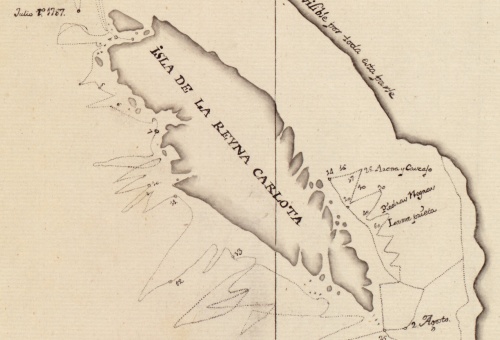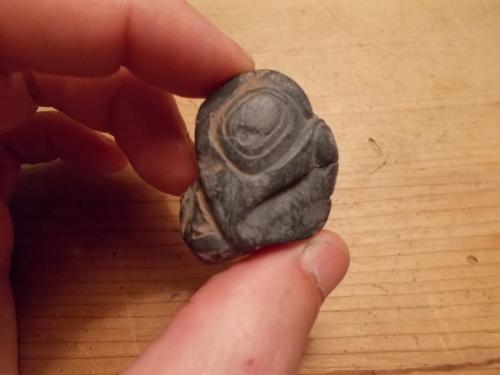
Dixon’s 1787 map showing Haida Gwaii as an Island. Source: Library of Congress
Old Maps are Cool. Enough said. Or maybe not quite enough. Continue reading

Dixon’s 1787 map showing Haida Gwaii as an Island. Source: Library of Congress
Old Maps are Cool. Enough said. Or maybe not quite enough. Continue reading
Posted in archives, First Nations, Haida Gwaii, history, Northwest Coast
Tagged Captain Dixon, cartography, charts, Haida Gwaii, Haida Nation, maps

NW Coast stone carving found in Chumash Territory, California. Source: http://www.arrowheadology.com/forums/showthread.php?t=42646&p=359269&viewfull=1#post359269
If someone out there in webland makes a link to my blog, and then someone else clicks on that link, I might be able to tell which site is referring to me. Sometimes this leads to unexpected discoveries. One of these incoming links is a query to an artifact collecting forum (boo) from a collector in southern California, who found the above small sculpture in Chumash territory. As is so common in the collector world, there is no other contextual information about this piece, which to my eye, appears to be an early historic Haida carving in argillite. Knowledgeable readers may wish to weigh in below in the comments section about the motifs and provenance of this sculpture – there are more fairly low-quality pictures here. How it made its way to the Santa Barbara area is anyone’s guess, it may have been a simple curio bought by a tourist, or it may be a now-lost bit of evocative human history like the one I suggested here for Haida argillite found on San Juan Island.

NW Coast stone carving found in Chumash Territory, California. Source: http://www.arrowheadology.com/forums/showthread.php?t=42646&p=359269&viewfull=1#post359269
Posted in Archaeology, California, Cultural Resource Management, Haida Gwaii, history, Northwest Coast
Tagged Archaeology, argillite, art, british columbia, California, Chumash, collecting, Haida, Haida Gwaii, pothunting, sculpture
The Victoria Chapter of the Archaeological Society of BC (ASBC) has a long-running monthly Fall-Spring speaker series which is starting again next week. The speaker is UVic Anthropology graduate student Jenny Cohen, speaking on results from her paleobotanical analysis of the 10,700 year old intertidal wet site, Kilgii Gwaay, in southern Haida Gwaii. It’s a fascinating site which gives real insight into the way of life of Ancestral Haida at the Pleistocene-Holocene transition and I’m sure Jenny’s thesis, nearing completion, will be of wide interest.
If you don’t have enough Kilgii Gwaay in your life then I recommend you jump over to the Burnt Embers blog, where there are some excellent photos from the tricky intertidal excavations at that site a few years ago: Setting Up; Keeping Water Out; Putting Water In; Water Screening; and Kilgii Gwaay Finds.
Abstract: Continue reading

Unusual fish hook fashioned from a canine tooth. Ca. 3000 years old, Burnaby Narrows, Haida Gwaii, 2012. Photo by Jenny Cohen.
Quick note to say there are two forthcoming public talks that might be of interest to residents of Vancouver or Victoria. The Vancouver one is by Dr. Ken Ames, Professor Emeritus at Portland State University, speaking at UBC on Thursday October 18th at 11.30. The Victoria one is by yours truly, speaking to the Archaeological Society of BC on Tuesday October 16th at 7.30. Details are below. Continue reading
Posted in Archaeology, First Nations, Haida Gwaii, Northwest Coast, Oregon
Tagged ASBC, Haida Gwaii, Ken Ames, Kilgii Gwaay, ubc
So I’ve never posted job ads here before and I may never do so again, but there are two ones posted right now with a lot of potential for readers of this blog: one is an archaeological position with the Council of the Haida Nation (PDF), the other a tenure track position in archaeological sciences at Washington State University.
Posted in Archaeology, Cultural Resource Management, First Nations, Haida Gwaii, Northwest Interior, Northwest Coast, Teaching, Uncategorized, Washington State
Tagged Archaeology, CHN, Council of the Haida Nation, CRM, Cultural Resource Management, Haida Gwaii, jobs, Washington State University, WSU
E. James (Jim) Dixon, now at the University of New Mexico, is pretty well known on the Northwest Coast for his pioneering work at the 10 to 12,000 year old 49-PET-408 (“On Your Knees Cave”) in the Alaskan Panhandle, and more recently for his exciting work on Alaskan Ice Patches. I see now that he apparently received some funding to go underwater during the summer of 2010 in the waters around PET-408, not far north from the aptly named Dixon Entrance, in Southeast Alaska (map). This work could have implications for the coastal route of First Peopling of the Americas.
I found myself poking around in a New Zealand archive at the University of Canterbury the other day and found some nice historic pictures from the NW Coast. These are assigned to the collection of John Macmillan Brown, an early New Zealand academic and, in retirement, an amateur anthropologist. I am guessing these pictures were taken by him in retirement. Most are undated; one carries a date of 1924. The subjects are familiar yet the views are new – the more we can catalogue the world’s pictures of the NW Coast, the better we can understand the processes of transformation which continue to unfold.
Update: fixed links, sort of. Note to web types: you should always provide stable URLs, none of this “your search has expired” junk. If you want your collections used, and you do, because you put them on the web, you need to make it so the results can be bookmarked and shared. Gosh.
Posted in anthropology, Archaeology, archives, First Nations, Haida Gwaii, history, Northwest Coast, pics
Tagged anthropology, Haida Gwaii, Haida Nation, history, Massett, New Zealand, Northwest Coast, photography, Skidegate
The Collison Bay site in Haida Gwaii posed some unusual challenges, some natural and others of our own making. The site is found in the intertidal zone and dates, like the Kilgii Gwaay site about 10 km away, to a brief window about 10,700 calendar years ago. I posted the above picture before, but without annotation. That previous post describes something of the site formation processes, which mean a site which was terrestrial when occupied is now in the intertidal zone, and excavation must take place between the tides.
Looking at the above, you can see we didn’t plan for the tides very well! other projects required us to be elsewhere and when it was Collison Bay’s turn, the low tides were in the middle of the night. This meant we had to get up at midnight to work until about 6.00 in the morning the first night to catch the falling tide, then we got up about 12.45, then about 1.30, and so on: tracking the procession of the low tides. So, to the inherent complications of working in the intertidal zone we did it in the dark, running electric lights from a generator. This actually worked really well and data recovery was excellent – we dug there on another occasion in the daytime (see below) and there was no real difference in quality of work. Also part way through this project we were working until mid-morning and could see pretty well!
The site includes numerous water-worn stone tools on the surface and in the upper beach deposits, but in the lower beach deposits the tools are pristine and show no signs of water-rolling. In many cases they lie flat, also suggesting a lack of disturbance, and they are encased in a thin, brown layer of jelly-like material which is the organic remains of a degraded soil. Unlike at Kilgii Gwaay, there is no survival of bone or wood. Nonetheless, the stone tools are very similar to that site, and speak to a terminal Pleistocene technological approach using discoidal and uni-directional cores to create large blade-like flakes. Too much information for some readers I bet – but the take home message is this way of making stone tools might be peculiar to the Pacific Rim and not the continental interior and therefore might, perhaps, maybe, one day, turn out to have significance for the coastal route of the First Peopling of the Americas.
Posted in Archaeology, fieldwork, Haida Gwaii, Northwest Coast
Tagged annotation, Collison Bay, Gwaii Haanas, Haida Gwaii, Intertidal, Kilgii Gwaay, lithics, stone tools
The Northwest Coast is rightly famous for the superb dugout canoes made by First Nations, a craft which continues to the present day. It takes weeks or months to carve a canoe from a single log of red cedar – imagine then the tension inherent in having a big part of the success or failure “boil down” to a single event the steaming process. The video above shows master carvers Joe and Carl Martin of the Nuu-chah-nulth nation steaming a canoe at a beach near Tofino, on western Vancouver Island.
Steaming softens the cedar and makes it more flexible, allowing the insertion of carefully-measured, carefully-planned wooden spacers which spread the middle of the canoe into a graceful curve, increasing its buoyancy, resistance to capsizing, and introducing subtle yet beautiful lines, as seen in this enormous example mis-labelled (I think) as Salish. After the canoe cools and dries, the wood returns to its natural properties. The process means the canoe can in principle be wider than the single piece of cedar from which it is carved.
You can click here to see a slide show of the steaming of a Haida canoe carved by the team of Jaalen Edenshaw and his father Guujaw. In the old times, a canoe might be roughed out in the bush then hauled to the beach for finishing. Sometimes flaws in the wood or other interruptions mean a canoe was never finished. Such half-finished vessels are a known, but uncommon archaeological site in the woods of coastal British Columbia.
The carving of such canoes is increasingly common. Nowadays, the canoe log is likely to be hauled to a carving shed. Sadly, a major constraint on canoe construction is the difficulty in obtaining prime, straight, clear, old-growth cedar logs.
The Council of the Haida Nation has an informative website with many links to documents and other material, giving a vivid picture of the vibrancy, and challenges, of contemporary Haida culture.
Among the interesting items on that page, the “Our World” series of short videos which deftly mix ancient and modern are particularly worth checking out:
These are the among the visions of young Haida today.
Posted in anthropology, First Nations, Haida Gwaii
Tagged film, Haida, Haida Gwaii, Haida Nation, photography, video, youth